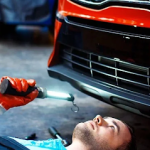Building your own vehicle can be a thrilling venture, particularly when you have a passion for automobiles. Vehicle enthusiasts invest copious amounts of time and resources into creating their own unique and personalized cars. However, before you can enjoy the open road in your custom-built car, there are several legal steps you need to take to ensure your vehicle is road-legal. Specifically in the UK, you’ll be dealing with agencies like the Driver and Vehicle Licensing Agency (DVLA). This guide will help you navigate the registration process, step by step.
Getting a Vehicle Identification Number (VIN)
Your first step in the registration process is to acquire a Vehicle Identification Number (VIN) for your custom-built car. The DVLA is responsible for issuing VINs. To apply for a VIN, you will need to complete the relevant application form and provide evidence that the car is indeed your own creation.
Also to discover : How can you effectively reduce vibration and noise in an older UK car model?
This process is crucial because the VIN is a unique identifier for your vehicle, similar to a human’s fingerprints. It will be used in all legal paperwork and records relating to the vehicle. The VIN will also aid in identifying and tracking your vehicle in case of theft or other legal matters.
Applying for a Vehicle Registration Certificate (V5C)
Once you have your VIN, the next step is to apply for a Vehicle Registration Certificate, also known as a V5C. This document is essentially the car’s birth certificate, containing important information like the vehicle’s make, model, and year of creation.
Also to see : What techniques can improve the sound quality of a UK car’s stock audio system?
To apply for a V5C, you’ll need to fill out a V55/5 form. This form will ask for details about the vehicle, your details as the car’s owner, and the VIN. It’s crucial to fill out this form accurately and honestly – providing false information can lead to fines or even imprisonment.
Undergoing an Individual Vehicle Approval (IVA) Test
The Individual Vehicle Approval (IVA) test is the UK’s method of ensuring that all vehicles operating on its roads are safe and meet environmental standards. Your custom-built car will need to pass this test before it can be registered.
The IVA test includes checks on the vehicle’s brakes, lights, tires, and emissions. To prepare your car for the IVA test, you’ll need to ensure that it complies with all relevant safety and environmental regulations. For example, your car’s emissions will need to meet the Euro 6 standards to pass the IVA test.
Paying Vehicle Tax and VAT
Before your vehicle can be officially registered, you’ll need to pay vehicle tax. The amount of tax you’ll need to pay will depend on the vehicle’s CO2 emissions. The lower the emissions, the lower the tax.
In addition to vehicle tax, you may also need to pay Value Added Tax (VAT) if your vehicle was built using new parts. The standard VAT rate in the UK is 20%.
Registering Your Custom-Built Car With The DVLA
The final step in the process is to register your custom-built car with the DVLA. You’ll need to send the completed V55/5 form, proof of identity, proof of address, the VIN, the V5C, and evidence of the vehicle tax and VAT payment to the DVLA.
Once the DVLA has received and processed all your documents, they will register your vehicle and issue you with a registration number. This number will need to be displayed on your car’s number plate.
Remember, registering your custom-built car is not just about making it road-legal – it’s also about ensuring that your car meets safety and environmental standards. The process might seem tedious, but it’s essential to ensure that your vehicle is safe for you and other road users. Furthermore, it’s a legal requirement that must be fulfilled before you can fully enjoy the fruits of your labor. So, as you embark on the journey of building your own car, bear these steps in mind to make the registration process as smooth as possible.
Personalised Number Plates for Your Custom-Built Car
While you are registering your vehicle and obtaining a registration number, it might be a good opportunity to consider getting a personalised number plate. This is not required, but it adds a unique touch to your custom-built car, further enhancing its uniqueness.
Personalised number plates can be a combination of letters and numbers that hold personal significance to you. For instance, it might be your initials, an important date, or a word that has significant meaning to you. Custom number plates can also be a fun way to express your personality or interests.
To get a personalised plate, you will need to check the availability of your preferred combination on the DVLA’s website. If it’s available, you can purchase it directly from the DVLA or through a private number plate dealer. Remember to ensure that the plate complies with the DVLA’s regulations concerning size, style, and spacing. If your custom-built car is a classic car, there may be specific requirements regarding the type of number plate you can use.
One important point to bear in mind when purchasing a personalised number plate is that the vehicle registration year identifier (the two numbers in the middle of the plate) should not make the vehicle appear newer than it is. This is a legal requirement. For example, a car registered in Northern Ireland in March 2024 must not have a number plate with the registration year identifier as “24” which is assigned for vehicles registered in mainland UK between March and September of the same year.
Conclusion: Completing the Registration of Your Custom-Built Vehicle
Registering a custom-built car in the UK involves several legal steps, from obtaining a Vehicle Identification Number (VIN) to paying vehicle tax and VAT. It also includes the crucial step of undergoing an Individual Vehicle Approval (IVA) test, which ensures that your vehicle meets safety and environmental standards.
Getting a personalised number plate is an optional step that can add a personal touch to your custom-built car. However, it is crucial to ensure that the plate complies with DVLA’s regulations and does not make the car appear newer than it is.
The process of registering your custom-built car might seem daunting, but it is crucial to ensure your vehicle is safe, meets environmental standards, and is legally roadworthy. Moreover, it’s a legal requirement you must fulfill before you can fully enjoy your custom-built car.
While you are working on your project, always keep in mind the steps you need to take to get your vehicle registered. This will help you to prepare the necessary documents and to ensure that your car meets the necessary requirements from the start. This knowledge will make the process smoother and quicker, allowing you to enjoy the fruits of your labour as soon as possible.
Remember, the journey of building and registering your own car is a testament to your passion for automobiles. Every step you take is bringing you closer to your dream of driving your own custom-built car on the open roads of the UK.












